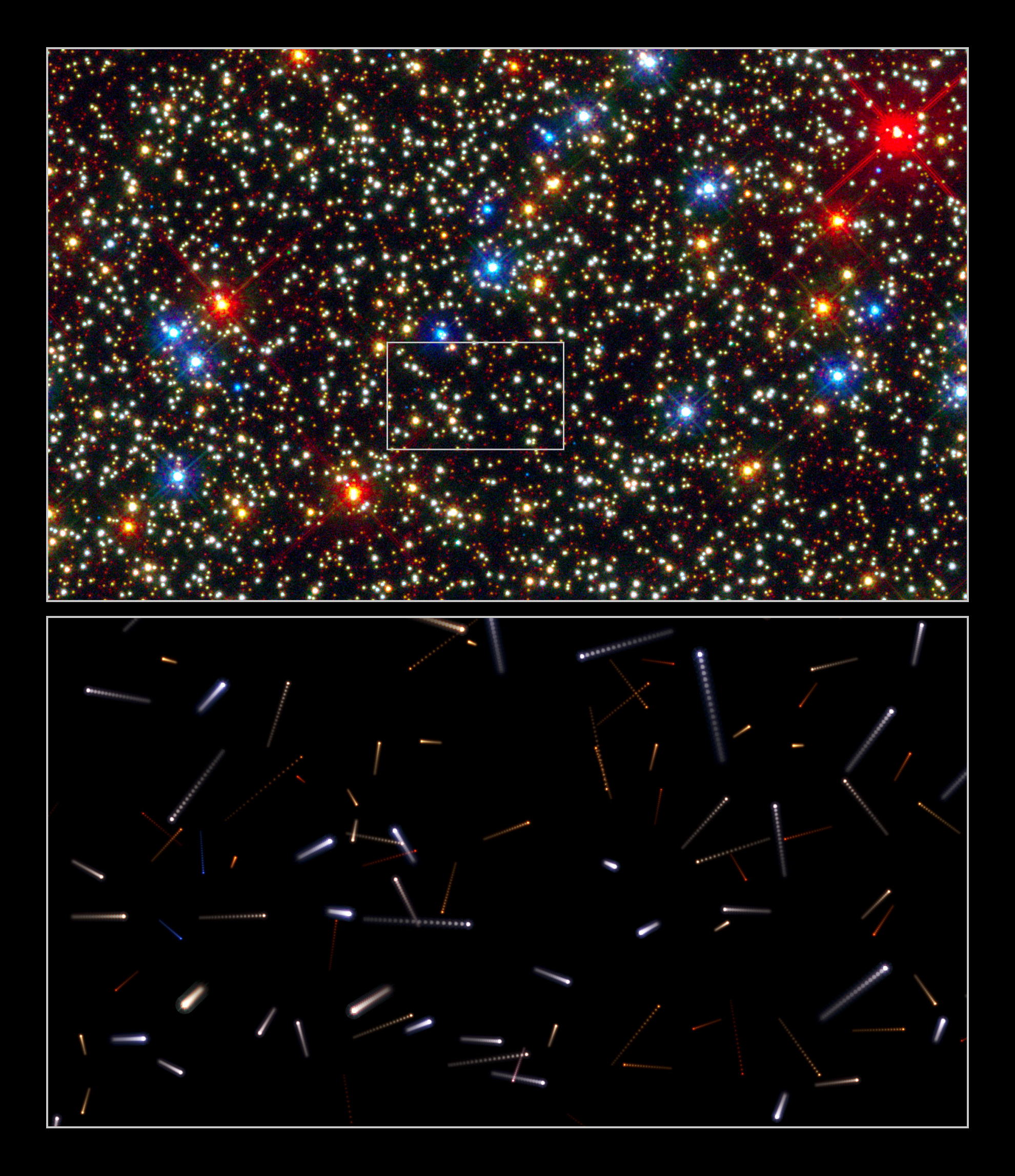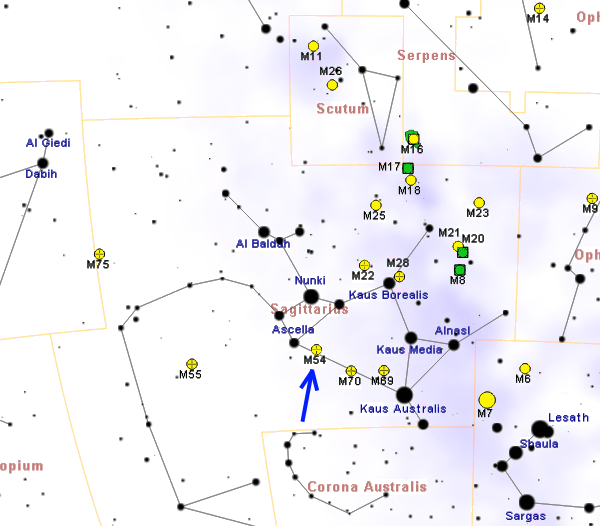|
NGC 2808
NGC 2808 is a globular cluster in the constellation Carina. The cluster belongs to the Milky Way, and is one of our home galaxy's most massive clusters, containing more than a million stars. It is estimated to be 12.5-billion years old. The cluster is being disrupted by the galactic tide, trailing a long tidal tail. Star generations It had been thought that NGC 2808, like typical globular clusters, contains only one generation of stars formed simultaneously from the same material. In 2007, a team of astronomers led by Giampaolo Piotto of the University of Padua in Italy investigated Hubble Space Telescope images of NGC 2808 taken in 2005 and 2006 with Hubble's Advanced Camera for Surveys. Unexpectedly, they found that this cluster is composed of three generations of stars, all born within 200 million years of the formation of the cluster. Astronomers have argued that globular clusters can produce only one generation of stars, because the radiation from first generation star ... [...More Info...] [...Related Items...] OR: [Wikipedia] [Google] [Baidu] |
New General Catalogue
The ''New General Catalogue of Nebulae and Clusters of Stars'' (abbreviated NGC) is an astronomical catalogue of deep-sky objects compiled by John Louis Emil Dreyer in 1888. The NGC contains 7,840 objects, including galaxies, star clusters and emission nebulae. Dreyer published two supplements to the NGC in 1895 and 1908, known as the ''Index Catalogues'' (abbreviated IC), describing a further 5,386 astronomical objects. Thousands of these objects are best known by their NGC or IC numbers, which remain in widespread use. The NGC expanded and consolidated the cataloguing work of William and Caroline Herschel, and John Herschel's ''General Catalogue of Nebulae and Clusters of Stars''. Objects south of the celestial equator are catalogued somewhat less thoroughly, but many were included based on observation by John Herschel or James Dunlop. The NGC contained multiple errors, but attempts to eliminate them were made by the ''Revised New General Catalogue'' (RNGC) by Jack W. Sulent ... [...More Info...] [...Related Items...] OR: [Wikipedia] [Google] [Baidu] |
Star
A star is an astronomical object comprising a luminous spheroid of plasma (physics), plasma held together by its gravity. The List of nearest stars and brown dwarfs, nearest star to Earth is the Sun. Many other stars are visible to the naked eye at night sky, night, but their immense distances from Earth make them appear as fixed stars, fixed points of light. The most prominent stars have been categorised into constellations and asterism (astronomy), asterisms, and many of the brightest stars have proper names. Astronomers have assembled star catalogues that identify the known stars and provide standardized stellar designations. The observable universe contains an estimated to stars. Only about 4,000 of these stars are visible to the naked eye, all within the Milky Way galaxy. A star's life star formation, begins with the gravitational collapse of a gaseous nebula of material composed primarily of hydrogen, along with helium and trace amounts of heavier elements. Its stellar ... [...More Info...] [...Related Items...] OR: [Wikipedia] [Google] [Baidu] |
Globular Clusters
A globular cluster is a spheroidal conglomeration of stars. Globular clusters are bound together by gravity, with a higher concentration of stars towards their centers. They can contain anywhere from tens of thousands to many millions of member stars. Their name is derived from Latin (small sphere). Globular clusters are occasionally known simply as "globulars". Although one globular cluster, Omega Centauri, was observed in antiquity and long thought to be a star, recognition of the clusters' true nature came with the advent of telescopes in the 17th century. In early telescopic observations globular clusters appeared as fuzzy blobs, leading French astronomer Charles Messier to include many of them in his catalog of astronomical objects that he thought could be mistaken for comets. Using larger telescopes, 18th-century astronomers recognized that globular clusters are groups of many individual stars. Early in the 20th century the distribution of globular clusters in the sky wa ... [...More Info...] [...Related Items...] OR: [Wikipedia] [Google] [Baidu] |
Monthly Notices Of The Royal Astronomical Society
''Monthly Notices of the Royal Astronomical Society'' (MNRAS) is a peer-reviewed scientific journal covering research in astronomy and astrophysics. It has been in continuous existence since 1827 and publishes letters and papers reporting original research in relevant fields. Despite the name, the journal is no longer monthly, nor does it carry the notices of the Royal Astronomical Society. History The first issue of MNRAS was published on 9 February 1827 as ''Monthly Notices of the Astronomical Society of London'' and it has been in continuous publication ever since. It took its current name from the second volume, after the Astronomical Society of London became the Royal Astronomical Society (RAS). Until 1960 it carried the monthly notices of the RAS, at which time these were transferred to the newly established ''Quarterly Journal of the Royal Astronomical Society'' (1960–1996) and then to its successor journal ''Astronomy & Geophysics'' (since 1997). Until 1965, MNRAS ... [...More Info...] [...Related Items...] OR: [Wikipedia] [Google] [Baidu] |
Omega Centauri
Omega Centauri (ω Cen, NGC 5139, or Caldwell 80) is a globular cluster in the constellation of Centaurus that was first identified as a non-stellar object by Edmond Halley in 1677. Located at a distance of , it is the largest-known globular cluster in the Milky Way at a diameter of roughly 150 light-years. It is estimated to contain approximately 10 million stars, and a total mass equivalent to 4 million solar masses, making it the most massive-known globular cluster in the Milky Way. Omega Centauri is very different from most other galactic globular clusters to the extent that it is thought to have originated as the core remnant of a disrupted dwarf galaxy. Observation history In 150 AD, Greco-Roman writer and astronomer Ptolemy catalogued this object in his ''Almagest'' as a star on the horse's back, "Quae est in principio scapulae". German cartographer Johann Bayer used Ptolemy's data to designate this object "Omega Centauri" with his 1603 publication of ''Uranometria''. Usin ... [...More Info...] [...Related Items...] OR: [Wikipedia] [Google] [Baidu] |
Messier 79
Messier 79 (also known as M79 or NGC 1904) is a globular cluster in the southern Lepus constellation, constellation Lepus. It was discovered by Pierre Méchain in 1780 and is about 42,000 light-years away from Earth and 60,000 light years from the Galactic Center. Like Messier 54 (the other extragalactic globular on Messier object, Messier's list), it is believed to not be native to the Milky Way galaxy at all, but instead to the putative Canis Major Dwarf Galaxy, which is currently experiencing a very close encounter with our galaxy. This is, however, a contentious subject as astronomers are still debating the nature of the Canis Major dwarf galaxy itself. The cluster is being disrupted by the galactic tide, trailing a long tidal tail. Color-magnitude diagram This Hertzsprung–Russell diagram, color-magnitude diagram was made using near-infrared images of the cluster in Photometric system#Photometric letters, J and K bands. J-band magnitude is plotted along the y-axis and J ... [...More Info...] [...Related Items...] OR: [Wikipedia] [Google] [Baidu] |
Messier 54
Messier 54 (also known as M54 or NGC 6715) is a globular cluster in the constellation Sagittarius. It was discovered by Charles Messier in 1778 and then included in his catalog of comet-like objects. It is easily found in the sky, being close to the star ζ Sagittarii. It is, however, not resolvable into individual stars even with larger amateur telescopes. In July 2009, a team of astronomers reported that they had found evidence of an intermediate-mass black hole in the core of M54. Distance Previously thought to belong to the Milky Way at a distance from Earth of about 50,000 light-years, it was discovered in 1994 that M54 most likely belongs to the Sagittarius Dwarf Elliptical Galaxy (''SagDEG''), making it the first globular cluster formerly thought to be part of our galaxy reassigned to extragalactic status, even if not recognized as such for nearly two and a quarter centuries. As it is located in SagDEG's center, some authors think it actually may be its core; howev ... [...More Info...] [...Related Items...] OR: [Wikipedia] [Google] [Baidu] |
Sausage Galaxy
A sausage is a type of meat product usually made from ground meat—often pork, beef, or poultry—along with salt, spices and other flavourings. Other ingredients, such as grains or breadcrumbs may be included as fillers or extenders. When used as an adjective, the word ''sausage'' can refer to the loose sausage meat, which can be formed into patties or stuffed into a skin. When referred to as "a sausage", the product is usually cylindrical and encased in a skin. Typically, a sausage is formed in a casing traditionally made from intestine, but sometimes from synthetic materials. Sausages that are sold raw are cooked in many ways, including pan-frying, broiling and barbecuing. Some sausages are cooked during processing, and the casing may then be removed. Sausage-making is a traditional food preservation technique. Sausages may be preserved by curing, drying (often in association with fermentation or culturing, which can contribute to preservation), smoking, or free ... [...More Info...] [...Related Items...] OR: [Wikipedia] [Google] [Baidu] |
Dwarf Galaxy
A dwarf galaxy is a small galaxy composed of about 1000 up to several billion stars, as compared to the Milky Way's 200–400 billion stars. The Large Magellanic Cloud, which closely orbits the Milky Way and contains over 30 billion stars, is sometimes classified as a dwarf galaxy; others consider it a full-fledged galaxy. Dwarf galaxies' formation and activity are thought to be heavily influenced by interactions with larger galaxies. Astronomers identify numerous types of dwarf galaxies, based on their shape and composition. Formation One theory states that most galaxies, including dwarf galaxies, form in association with dark matter, or from gas that contains metals. However, NASA's Galaxy Evolution Explorer space probe identified new dwarf galaxies forming out of gases with low metallicity. These galaxies were located in the Leo Ring, a cloud of hydrogen and helium around two massive galaxies in the constellation Leo. Because of their small size, dwarf galaxies have ... [...More Info...] [...Related Items...] OR: [Wikipedia] [Google] [Baidu] |
Advanced Camera For Surveys
The Advanced Camera for Surveys (ACS) is a third-generation axial instrument aboard the Hubble Space Telescope (HST). The initial design and scientific capabilities of ACS were defined by a team based at Johns Hopkins University. ACS was assembled and tested extensively at Ball Aerospace & Technologies Corp. and the Goddard Space Flight Center and underwent a final flight-ready verification at the Kennedy Space Center before integration in the cargo bay of the Columbia orbiter. It was launched on March 1, 2002, as part of Servicing Mission 3B (STS-109) and installed in HST on March 7, replacing the Faint Object Camera (FOC), the last original instrument. ACS cost US$86 million at that time. ACS is a highly versatile instrument that became the primary imaging instrument aboard HST. It offered several important advantages over other HST instruments: three independent, high-resolution channels covering the ultraviolet to the near-infrared regions of the spectrum, a large detector ar ... [...More Info...] [...Related Items...] OR: [Wikipedia] [Google] [Baidu] |
University Of Padua
The University of Padua ( it, Università degli Studi di Padova, UNIPD) is an Italian university located in the city of Padua, region of Veneto, northern Italy. The University of Padua was founded in 1222 by a group of students and teachers from Bologna. Padua is the second-oldest university in Italy and the world's fifth-oldest surviving university. In 2010, the university had approximately 65,000 students. In 2021, it was ranked second "best university" among Italian institutions of higher education with more than 40,000 students according to Censis institute, and among the best 200 universities in the world according to ARWU. History The university is conventionally said to have been founded in 1222 when a large group of students and professors left the University of Bologna in search of more academic freedom ('Libertas scholastica'). The first subjects to be taught were law and theology. The curriculum expanded rapidly, and by 1399 the institution had divided in two: a ''Univ ... [...More Info...] [...Related Items...] OR: [Wikipedia] [Google] [Baidu] |
Giampaolo Piotto
Giampaolo or Gianpaolo is an Italian male given name or surname. Its English translation is " John Paul". It is often short for "Giovanni Paolo". Notable people with the name include: Given name *Gianpaolo Ambrosi, Italian luger *Gianpaolo Bellini, Italian footballer *Giampaolo Caruso, Italian road bicycle racer *Giampaolo Mazza, Sammarinese manager * Giampaolo Menichelli, Italian footballer *Gianpaolo Mondini, Italian former road bicycle racer *Giampaolo Pazzini, Italian footballer *Giampaolo Rugarli, Italian novelist *Giampaolo Stuani, Italian pianist *Giampaolo Urlando, Italian hammer thrower Surname *Dominic Giampaolo, American software developer *Federico Giampaolo, Italian footballer *Marco Giampaolo, Italian football manager See also *Giovanni (name) *Paolo (other) Paolo is both a given name and a surname, the Italian form of the name Paul. Notable people with the name include: People with the given name Paolo Art * Paolo Alboni (1671–1734), Italian painter ... [...More Info...] [...Related Items...] OR: [Wikipedia] [Google] [Baidu] |








